A DOT audit or review determines a company’s Federal Motor Carrier Safety Regulations (FMCSR) compliance. It evaluates safety performance and confirms that the owner-operator and the trucking firm is managing their proper recordkeeping. It’s usually done at the trucker’s place of business although right now, most are being handled via telephone, online meetings, or by using a fax machine. Either way, TruckingOffice PRO will help you pass this audit.
What does the DOT audit cover?
US DOT reviews six categories to ensure that a company is doing what is expected when it comes to a motor carrier’s safety program. The six categories are:
- General
- Driver
- Operational
- Vehicle
- Hazardous Materials
- Accidents
Motor carriers are responsible for knowing and complying with all FMCSR and DOT regulations and recordkeeping mandates.
What are some other things you need to know that will help you pass a DOT audit? The following information may prove helpful.
Category 1: General
Motor carriers must show documentation proving proper liability insurance is in place. Forms MCS-90 (382.15) should be available for examination and signed by the insurance provider.
You’ll also need to provide an accident register as defined in Section 390.5 of the FMCSR’s list of DOT recordable accidents. The information should include the date, location, and driver’s name. It should include injuries, fatalities, or hazardous materials spilled during the accident.
(Like most owner-operators, you want to drive a truck, not do paperwork. TruckingOffice trucking management software gets you out from behind the desk and into the driver’s seat where you’re making money. Our complete trucking accounting system tracks
- dispatches
- invoices
- payments
- late payments
- customer information.
(It’s not just about the audits. It’s about making your business a success.)
Category 2: Driver
CMV drivers must have valid licenses and have undergone drug and alcohol testing. The testing program is described in the FMCSR under parts 40 and 382. A signed receipt from each driver should be on file and readily available during the inspection. DOT regulations also require the following tests:
- Pre-Employment (382.301)
- Post-Accident Drug and Alcohol (382.303)
- Random Drug and Alcohol (382.305)
- Reasonable Suspicion (382.307)
All driver files must be current and contain complete and correct information.
(TruckingOffice’s driver management module will help you keep track of all this data and be sure that your drivers are paid correctly and on time.)
Category 3: Operational
All CMV businesses are subject to HOS record keeping with six months of driver logs and supporting documents available for review. DOT will examine the logs for the following violations:
- Form and Manner
- Hours of Service
- False Information
A list of the requirements under this category can be found here.
(TruckingOffice’s ELD is totally compliant with all DOT regulations and works with our trucking management software so you can be sure that your IFTA, IRP, invoices, and maintenance logs are all ready for an audit!)
Category 4: Vehicle
According to DOT standards, CMVs are required to be enrolled in a program of systemic maintenance. As well as repair, and inspection. The information provided during an audit should include company number or license place number. As well as model and year, VIN, tire size, and owner. Additionally, 14 months of inspection reports must be kept in the vehicle. Or the vehicle must have an approved inspection sticker visible.
(Keeping track of maintenance completed is necessary, but wouldn’t you want to be notified ahead of time when you need to schedule your truck’s maintenance? With TruckingOffice’s maintenance module, you get both. Avoid the expensive breakdown on the road by keeping up with your truck’s scheduled maintenance.)
Category 5: Hazardous Materials
Carriers must provide proof that their drivers have completed the required hazardous materials transport training. This includes storage information and licenses. As well as placards, or labels. A complete list of hazmat requirements can be found here.
(You have to keep track of all these details. TruckingOffice makes it easy.)
Category 6: Accidents
Carriers must maintain a record of all driver accidents and injuries. Carriers must also provide clear and accurate records of driver start and stop times, on-duty hours, and the 60-or 70-hour rule tracking. More information about how FMCSA monitors motor carrier safety can be found here.
(TruckingOffice is all about making your time on the road as safe as possible. That’s why you have access to PC*Miler to plan your routes for the best delivery service possible with TruckingOffice Pro.)
How to Pass Your DOT Audit
We believe the key to passing your DOT audit is based on being a good trucker and a good trucking manager. You understand the rules of the road and the DOT regulations and follow both. But sometimes an audit comes along when you’re not expecting it. That can make you very worried, especially if your required information is not organized.
When you get notified that you’re going to be audited, you need to get organized.
DOT Audits are Easier with TruckingOffice
Hopefully, your DOT audits will end well but why leave it to chance? With our TruckingOffice trucking management solution, all of your records are accurate, current, and easily available. To ensure you are compliant with DOT standards, you need a system that will manage all this data for you, keep it organized and accessible upon demand. Instead of looking at a DOT audit as a crisis, TruckingOffice will have everything you need to give you the peace of mind that this DOT audit is something you don’t have to worry about.
Instead of trying to find a paper in a shoebox or lost in a file cabinet, you can use TruckingOffice to do all the work for you. If you’d like to know more about our system, sign up for the sign up now for a free trial today. We’re here to make your job easier and help you grow your operation.







Please quote